【README】
- 1.本文源代码总结自B站《netty-尚硅谷》;
- 2.本文介绍了tcp粘包拆包问题;
- 3.本文po 出了粘包拆包问题解决方案及源代码实现;
【1】tcp粘包拆包问题
refer2 How to deal with the problem of packet sticking and unpacking during TCP transmission? - 编程知识
【1.1】粘包拆包问题描述
- 假设客户端发送2个连续的数据包到服务器,数据包用packet1,packet2分别表示,则服务器接收到的数据可以分为3种情况;
1)情况1: 服务器接收到2个数据包,没有拆包,也没有粘包问题;
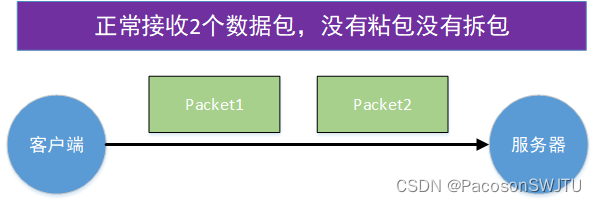
2)情况2: 服务器只接收到一个数据包(存在粘包问题)
- 因为tcp不会丢失数据包,因此这一个数据包就封装了2个原生数据包的信息,这种现象叫做粘包。
- 在这种情况,接收者并不知道2个原生包的界限,因此接收者很难处理;

3)情况3: 接收者接收到2个冗余或不完整的数据包(粘包与拆包问题同时发生)
- 接收者接收到2个数据包,但这2个数据包要么不完整,要么掺杂了其他数据包的部分数据。
- 在这种情况下,粘包与拆包同时发生。
- 如果这2个包不被特殊处理,对于接收者来说也很难处理;
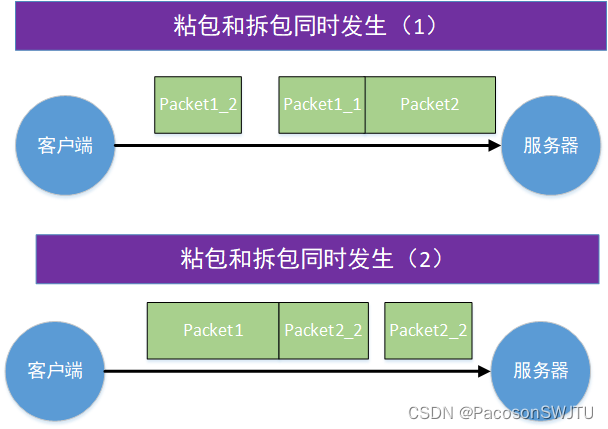
【1.2】代码演示粘包拆包问题
注意:
- 限于篇幅,本节没有po出全部代码, 能够表达意思即可;
1)业务场景:客户端连续发送10条消息(字符串)到服务器,查看服务器接收情况;
2)客户端发送消息代码: 
3)服务器接收消息代码:
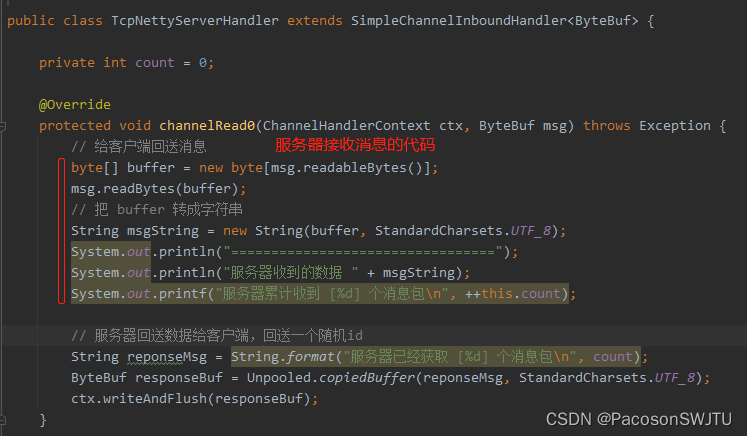
3.1)服务器接收消息的打印效果:
=================================
服务器收到的数据 hello server0服务器累计收到 [1] 个消息包
=================================
服务器收到的数据 hello server1服务器累计收到 [2] 个消息包
=================================
服务器收到的数据 hello server2
hello server3
hello server4
hello server5
hello server6服务器累计收到 [3] 个消息包
=================================
服务器收到的数据 hello server7
hello server8
hello server9服务器累计收到 [4] 个消息包【效果解说】
- 客户端发送了10条消息,服务器接收到了 4个数据包,而不是10个数据包 ;
- 显然,发生了tcp粘包;
- 这10条消息本来是10个数据报文,却被合并(粘)为4个数据包;
- 问题是: 如何把这4个数据包还原为10个数据包呢 (在高并发情况下,各式各样的数据包会更多)
- 如果无法还原,则服务器无法正确解析报文并做相应处理;
【2】 粘包与拆包原因
1)粘包原因:
- 发送的数据大小 小于 发送缓冲区,tcp就会把发送的数据多次写入缓冲区,此时发生粘包;
- 接收数据方的应用层没有及时从 接收缓冲区读取数据,也会发生粘包;
2)拆包原因:
- 发送的数据大小 大于 tcp发送缓冲区,就会发生拆包;
- 发送的数据大小 大于 报文最大长度,也会拆包;
【3】粘包拆包解决方法
解决粘包拆包的关键在于 为每一个数据包添加界限标识,常用方法如下:
- 方法1)发送方为每一个数据包添加报文头部。头部至少包含数据包长度(类似http协议的头部length)。 通过这种方式,接收方通过读取头部的长度知道当前数据包的界限,并在界限处停止读取。
- 方法2)发送方以固定长度封装数据包。如果不足,则补0填充。
- 方法3)自定义设置数据包的界限标识,如添加特别标识(如======)。接收方通过标识可以识别不同的数据包;
【4】粘包拆包问题解决的源代码实现
解决方法是:采用方法1,设置每个数据包的长度到报文头部;
【4.1】协议数据包封装类
/*** @Description 协议数据包* @author xiao tang* @version 1.0.0* @createTime 2022年09月10日*/
public class ProtocolMessage {private int length;private byte[] content;/*** @description 构造器* @author xiao tang* @date 2022/9/10*/public ProtocolMessage() {}public int getLength() {return length;}public void setLength(int length) {this.length = length;}public byte[] getContent() {return content;}public void setContent(byte[] content) {this.content = content;}
}【4.2】服务器
1)服务器 :
public class ProtocolNettyServer89 {public static void main(String[] args) throws InterruptedException {EventLoopGroup bossGroup = new NioEventLoopGroup(1);EventLoopGroup workerGroup = new NioEventLoopGroup();try {ServerBootstrap serverBootstrap = new ServerBootstrap();serverBootstrap.group(bossGroup, workerGroup).channel(NioServerSocketChannel.class).childHandler(new ProtocolNettyServerInitializer()); // 自定义一个初始化类// 自动服务器ChannelFuture channelFuture = serverBootstrap.bind(8089).sync();System.out.println("服务器启动成功");// 监听关闭channelFuture.channel().closeFuture().sync();} finally {bossGroup.shutdownGracefully();workerGroup.shutdownGracefully();}}
}2) 服务端初始化器:
public class ProtocolNettyServerInitializer extends ChannelInitializer<SocketChannel> {@Overrideprotected void initChannel(SocketChannel ch) throws Exception {ChannelPipeline pipeline = ch.pipeline();// 添加入站解码器-把字节转为协议报文便于业务逻辑处理pipeline.addLast(new ProtocolMessageDecoder());// 添加出站编码器-把协议报文转为字节便于网络传输pipeline.addLast(new ProtocolMessageEncoder());// 添加业务逻辑handlerpipeline.addLast(new ProtocolNettyServerHandler());}
}3)处理器:
public class ProtocolNettyServerHandler extends SimpleChannelInboundHandler<ProtocolMessage> {private int count = 0;@Overrideprotected void channelRead0(ChannelHandlerContext ctx, ProtocolMessage msg) throws Exception {// 接收到数据并处理int length = msg.getLength();String bodyStr = new String(msg.getContent(), StandardCharsets.UTF_8);System.out.println("====================================");System.out.println("服务器接收的消息如下:");System.out.println("报文长度:" + length);System.out.println("报文体内容: " + bodyStr);System.out.println("服务器累计接收到的消息包数量 = " + ++this.count);// 回复客户端byte[] body = ("我是服务器" + count).getBytes(StandardCharsets.UTF_8);int responseLen = body.length;// 构建一个响应协议包ProtocolMessage responseMsg = new ProtocolMessage();responseMsg.setLength(responseLen);responseMsg.setContent(body);ctx.writeAndFlush(responseMsg);}@Overridepublic void exceptionCaught(ChannelHandlerContext ctx, Throwable cause) throws Exception {cause.printStackTrace();ctx.close();}
}【4.3】客户端
1)客户端:
public class ProtocolNettyClient89 {public static void main(String[] args) throws InterruptedException {EventLoopGroup group = new NioEventLoopGroup();try {Bootstrap bootstrap = new Bootstrap();bootstrap.group(group).channel(NioSocketChannel.class).handler(new ProtocolNettyClientInitializer()); // 自定义一个初始化类// 连接服务器ChannelFuture channelFuture = bootstrap.connect("localhost", 8089).sync();channelFuture.channel().closeFuture().sync();} finally {group.shutdownGracefully();}}
}2)初始化器:
public class ProtocolNettyClientInitializer extends ChannelInitializer<SocketChannel> {@Overrideprotected void initChannel(SocketChannel ch) throws Exception {ChannelPipeline pipeline = ch.pipeline();// 添加出站处理器- 协议报文转字节以便网络传输pipeline.addLast(new ProtocolMessageEncoder());// 添加入站解码器-把字节转为协议报文对象以便业务逻辑处理pipeline.addLast(new ProtocolMessageDecoder());// 添加一个自定义handler,处理业务逻辑pipeline.addLast(new ProtocolNettyClientHandler());}
}3)处理器:
public class ProtocolNettyClientHandler extends SimpleChannelInboundHandler<ProtocolMessage> {private int count;@Overrideprotected void channelRead0(ChannelHandlerContext ctx, ProtocolMessage msg) throws Exception {// 读取服务器响应报文int length = msg.getLength();byte[] body = msg.getContent();System.out.println("=============================");System.out.println("客户端接收的消息如下:");System.out.println("长度 = " + length);System.out.println("报文体 = " + new String(body, StandardCharsets.UTF_8));System.out.println("客户端累计接收的消息包数量 = " + ++count);}@Overridepublic void channelActive(ChannelHandlerContext ctx) throws Exception {// 发送10条数据到服务器for (int i = 1; i <= 5; i++) {byte[] body = ("你好服务器,我是客户端张三" + i).getBytes(StandardCharsets.UTF_8);// 创建协议包对象ProtocolMessage message = new ProtocolMessage();message.setContent(body);message.setLength(body.length);// 发送ctx.writeAndFlush(message);}}@Overridepublic void exceptionCaught(ChannelHandlerContext ctx, Throwable cause) throws Exception {cause.printStackTrace();ctx.close();}
}【4.4】编码器与解码器
1)解码器
/*** @Description 协议报文解码器* @author xiao tang* @version 1.0.0* @createTime 2022年09月10日*/
public class ProtocolMessageDecoder extends ByteToMessageDecoder {@Overrideprotected void decode(ChannelHandlerContext ctx, ByteBuf in, List<Object> out) throws Exception {System.out.println("ProtocolMessageDecoder.decode() 被调用");// 把字节 转为 协议报文int length = in.readInt();byte[] body = new byte[length];in.readBytes(body);// 封装成 ProtocolMessage,放入out,送入下一个 Handler处理ProtocolMessage protocolMessage = new ProtocolMessage();protocolMessage.setLength(length);protocolMessage.setContent(body);// 添加到outout.add(protocolMessage);}
}2)编码器 :
/*** @Description 协议消息编码器* @author xiao tang* @version 1.0.0* @createTime 2022年09月10日*/
public class ProtocolMessageEncoder extends MessageToByteEncoder<ProtocolMessage> {@Overrideprotected void encode(ChannelHandlerContext ctx, ProtocolMessage msg, ByteBuf out) throws Exception {System.out.println("ProtocolMessageEncoder.encode() 被调用");out.writeInt(msg.getLength());out.writeBytes(msg.getContent());}
}【4.5】目录结构:
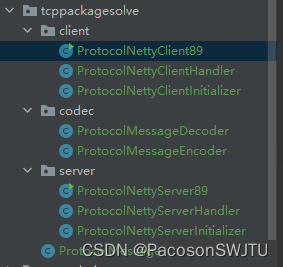
【4.6】打印效果:
1)客户端发送5条消息到服务器:
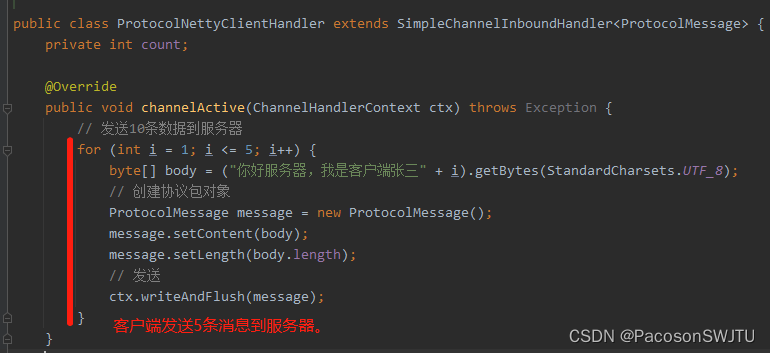
2)服务器接收的数据包为 5个,如下(显然没有发生拆包粘包问题):
ProtocolMessageDecoder.decode() 被调用
====================================
服务器接收的消息如下:
报文长度:40
报文体内容: 你好服务器,我是客户端张三1
服务器累计接收到的消息包数量 = 1
ProtocolMessageEncoder.encode() 被调用
ProtocolMessageDecoder.decode() 被调用
====================================
服务器接收的消息如下:
报文长度:40
报文体内容: 你好服务器,我是客户端张三2
服务器累计接收到的消息包数量 = 2
ProtocolMessageEncoder.encode() 被调用
ProtocolMessageDecoder.decode() 被调用
====================================
服务器接收的消息如下:
报文长度:40
报文体内容: 你好服务器,我是客户端张三3
服务器累计接收到的消息包数量 = 3
ProtocolMessageEncoder.encode() 被调用
ProtocolMessageDecoder.decode() 被调用
====================================
服务器接收的消息如下:
报文长度:40
报文体内容: 你好服务器,我是客户端张三4
服务器累计接收到的消息包数量 = 4
ProtocolMessageEncoder.encode() 被调用
ProtocolMessageDecoder.decode() 被调用
====================================
服务器接收的消息如下:
报文长度:40
报文体内容: 你好服务器,我是客户端张三5
服务器累计接收到的消息包数量 = 5
ProtocolMessageEncoder.encode() 被调用之良好的编程习惯)



之迭代控制:基本循环Loop)


之迭代控制:WHILE和FOR循环)
)

之显式游标简介)
canal背景与工作原理)


之使用显式游标属性)
centos8安装mysql)

)
之游标FOR循环)
